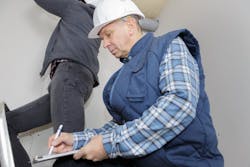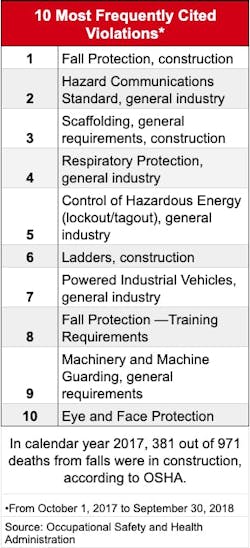Breaking the Fall
A roofing contractor in Akron, Ohio, was sentenced to three years in prison last September after pleading guilty to involuntary manslaughter in the death of a 39-year-old employee who, in November 2017, fell from a three-story roof while working without fall protection.
Construction-related falls from roofs, ladders, and scaffolding are perennially among the most-cited violations; in 2018, OSHA cited 15,400 violations related to fall protection and hazards.
“Over the past two years, DOL has been more stringent about requiring crews to have schooling in OSHA regs,” says Nick Totino, director of field operations for SilverLining, a New York-based contractor specializing in renovations and additions.
SilverLining is one of several remodelers and replacement contractors that Pro Remodeler interviewed in October about their methods for keeping installation crews in compliance with OSHA to avoid unwanted inspections, fines, or worse.
The interviewees generally agree that using subs as installers complicates their efforts. “Subs are easy to train, but harder to monitor,” observes Brad Roosevelt, director of operations for Tundraland Home Improvements in Wisconsin. “But they either do what they’re supposed to, or they don’t work for us.”
Training and Accountability
Lindus Construction, a full-service exterior contractor in Baldwin, Wis., does about 4,000 jobs annually (including kitchen remodels). Most of its 153 employees are installers.
The company has an on-staff safety director, Mike Downer, who trains employees and subs (which the company uses for roofing, concrete, plumbing and electrical, and masonry), and oversees jobsite safety. Every Monday, Lindus’ seven roofing supervisors have safety meetings with their installation crews, and each department within the company conducts a half-hour safety meeting.
Construction-related falls from roofs, ladders, and scaffolding are perennially among the most-cited violations; in 2018, OSHA cited 15,400 violations related to fall protection and hazards.
Co-owner Andy Lindus says that his crews get written up most frequently for not wearing eye and ear protection. Written warnings can be followed by suspensions and terminations for repeat offenders. But that threat doesn’t always deter installers from ignoring safety rules: Lindus recalls a 22-year-old installer who “thought it would be cool” to post a video on Facebook of crew members sliding down a roof into a snowbank.
Remodelers often call on OSHA experts for assistance. Lindus Construction brings in outside instructors to train its crews about ladder and scaffolding setups. Tundraland has sent some employees to Northwest Wisconsin Technical College for OSHA-certification courses. Roosevelt says that two employees have been certified, and two others—in its window division and HR department—are taking the courses.
All of Gardner/Fox’s employees receive 10 hours of OSHA training, and some get 30 hours. The company uses ClickSafety, which provides online courses.
George Cavalieri, Gardner/Fox’s director of commercial construction, acknowledges the challenges that compliance presents. Employees “sometimes can’t see the forest for the trees.” And subs often don’t have sufficient understanding of OSHA rules. In such cases Gardner/Fox stays in compliance by having at least one trained supervisor on the jobsite serve as the “competent person.”
SilverLining brings instructors into its offices to conduct after-work courses for 30-hour OSHA certification. On top of that, it sends supervisors to Andromeda Academy of Construction Trades in Queens, N.Y., for 32-hour site-safety classes that include eight hours on fall protection, eight hours on site-safety management, and four hours on handling workplace drug and alcohol issues.
Totino says about 15% of SilverLining’s employees have received “flagman” training (for closing off sidewalks and streets for materials and equipment) and scaffolding training.
Virginia-based HomeFix Custom Remodeling favors in-field training where it can observe and correct unsafe habits. Victor Martin, head of commercial operations, says that HomeFix’s Installation Services division enforces a “zero-tolerance policy” that “if you do not comply after being properly educated, you will be sent home for the day, without pay. You’re welcome to come back the following day, but we have a three-strike rule, [after which] they are permanently dismissed.”
The company’s Operations Manager is responsible for keeping abreast of OSHA rule changes.
Working With Subs
When OSHA cites jobsite violations, the general contractor is often the named party. So it behooves remodelers to hire subs who understand their safety obligations. Given the current labor shortage in construction, that’s easier said than done.
Tundraland’s roofing division’s uses subs exclusively. Roosevelt says it’s the responsibility of the subcontracting company providing those workers to keep its crews in compliance with OHSA. Tundraland stipulates contractually that subcontractors bear any liability for personal injury or property damage.
Other remodelers admit that keeping subs in compliance with OSHA can be a daily battle. “Not a week goes by when we’re not telling a sub about wearing shorts to a jobsite,” says Gardner/Fox’s Cavalieri. “And we’re near Lancaster [Pa.], where Amish labor has no idea about OSHA.”
Lindus says that paying subs better helps keep them in line because they are less prone to take shortcuts by skirting safety rules to save time and money. He notes, too, that improvements in equipment, such as retractable roof ropes, make it somewhat easier to get subs to practice safety first.
Each of HomeFix’s crews must have its own personal fall protection equipment, says Martin, including hard hats, high-visibility vests, proper shoes, safety glasses and gloves. Every truck must have a first-aid kit, and at least one crew member must be certified in CPR and first-aid training. Martin says that, at any given time, HomeFix has three to seven people in the field monitoring its crews’ activities.
SilverLining’s Totino meets monthly with his supervisors to go over the latest OSHA rules and to make sure that subs are receiving adequate safety training and information. “We only use a certain type of high-quality sub, not just someone off the street,” says Totino.
Some Projects Pose Greater Hazards
Last year, Gardner/Fox completed more than 100 residential projects that generated just over $8 million in revenue. The company also does commercial work, and Cavalieri believes that mix gives his company a leg up on jobsite safety “and being aware of what we need to do.”
Certain residential projects, however, require a higher level of attention. Cavalieri says it’s not uncommon to see subs on multifamily jobs passing building materials between floors that exceed the six-foot threshold OSHA has established as a fall hazard for construction that requires tethering or guardrails.
HomeFix recently completed a 50-unit single-family remodeling project on a military installation. Up to five crews were working side by side, “and each had its own work habits,” laments Martin. After a few days, HomeFix shut down construction because safety measures weren’t being implemented properly. It removed the onsite supervisor and brought in another “to get everyone on board with our way.”
Lindus says that paying subs better helps keep them in line because they are less prone to take shortcuts by skirting safety rules to save time and money.
Young families with small children occupied the houses, so there were “unique challenges,” says Martin, to keeping residents and bystanders safe. Perimeters were enforced with caution tape and cones at the immediate construction site. All tools, ladders, and materials “were within our boundary,” says Martin, limiting their exposure to residents. Special areas where the kids could play were cordoned off. Crew members at each site constantly picked up trash and swept the area with magnets for nails.
A Partner, Not An Adversary
While they might normally gripe about government regulations, the remodelers interviewed had no problem with OSHA. Totino believes the agency’s stepped-up enforcement is “a good thing,” given the recent spate of jobsite accidents involving cranes falling.
“The reality is that OSHA is there to help you and to keep people safe,” says Cavalieri. “The time and cost involved in being compliant pale beside the cost of dealing with the fallout of noncompliance.”


